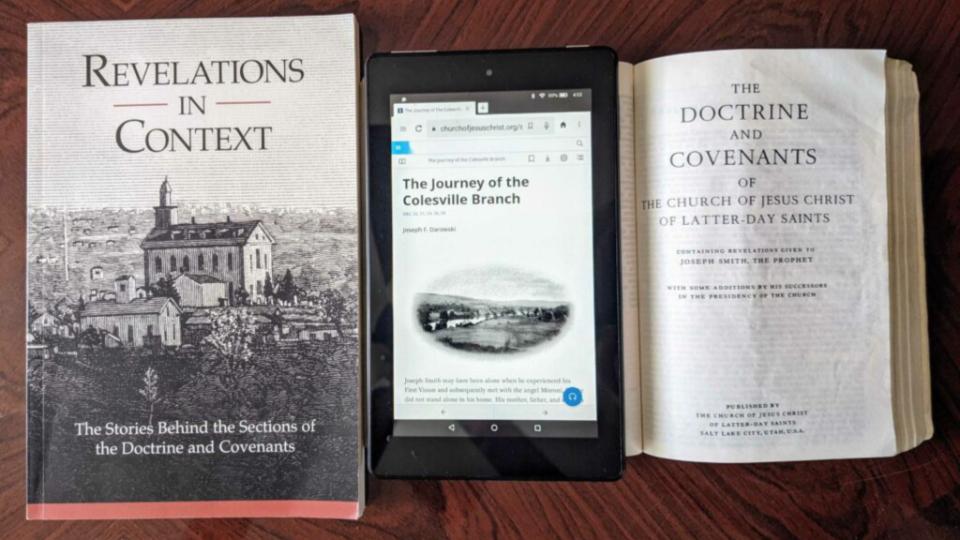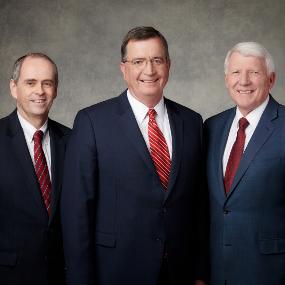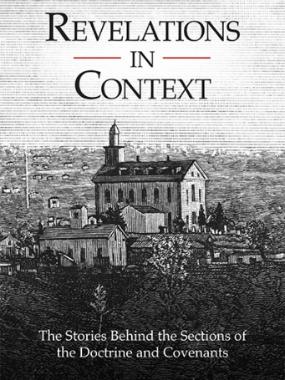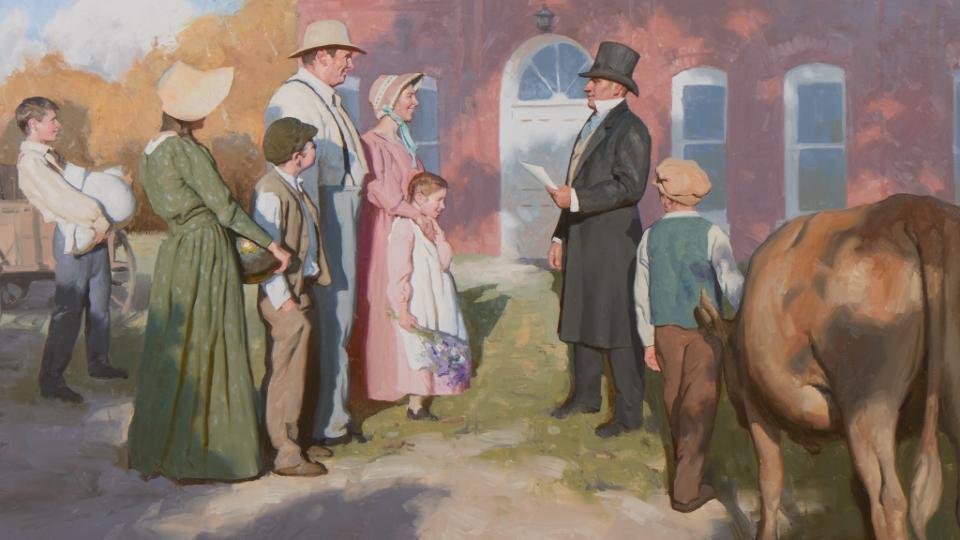
Revelations-in-Context
“Revelations in Context: The Stories Behind the Sections of the Doctrine and Covenants,” both physical and digital versions, are shown with the Doctrine and Covenants. “Revelations in Context” share the stories related to sections in the Doctrine and Covenants. Photo by Christine Rappleye, courtesy of Church News.All rights reserved.This story appears here courtesy of TheChurchNews.com
By Sydney Walker, Church News
In summer 1831, missionary companions Ezra Booth and Isaac Morley left Ohio for Missouri with high hopes. They, and 13 other pairs of missionaries, believed the Savior’s return was very near. They were traveling to locate and build a temple city in which they would gather for His coming.
After walking the entire distance in the summer heat, Booth and Morley arrived, deflated. The frontier town of Independence appeared to be “a century behind the times.” Surrounded by an open prairie with a few scattered trees and only a few Church members in sight, Booth and Morley found that Missouri was far from what they expected.
Booth’s experiences traveling to Missouri ultimately led him to abandon his faith. Morley’s experiences, however, strengthened his faith. After the Lord chastised Booth and Morley — “they condemned for evil that thing in which there was no evil,” He said — Morley changed his outlook, and the Lord forgave him (Doctrine and Covenants 64:16). Morley later served as a bishop and patriarch in the Church.
Booth and Morley’s story is one of many found in “Revelations in Context: The Stories Behind the Sections of the Doctrine and Covenants.”

Revelations-in-Context
The Sunday School general presidency are, from left to right, Brother Milton Camargo, first counselor; Brother Mark L. Pace, president; and Brother Jan E. Newman, second counselor. 2021 by Intellectual Reserve, Inc. All rights reserved.The stories in “Revelations in Context” recount not only the message the Lord was giving, “but also the context in which the message was being received,” said Sunday School General President Mark L. Pace. These stories can also help Latter-day Saints apply the Doctrine and Covenants to their lives today.
Brother Milton Camargo, first counselor in the Sunday School general presidency, said Booth and Morley’s story is a reminder of the need to continually strengthen one’s testimony to combat the adversary. When faced with disappointed and unexpected situations, “What’s going to be your decision?” Brother Camargo asked. “Are you going to give up and leave the kingdom of God, or will you repent and move forward on the covenant path?”
Echoing President Russell M. Nelson’s counsel to study the scriptures daily, the Sunday School general presidency encouraged Latter-day Saints to be aware of, use and enjoy “Revelations in Context” as they study the Doctrine and Covenants with “Come, Follow Me” this year.
“We know that as they do so, they will be blessed with an increased understanding and with continued revelation from the Holy Ghost that will bless their lives,” Brother Pace said.
What Is ‘Revelations in Context’?
“Revelations in Context” is a collection of narratives written by historians in the Church History Department that examines what prompted the revelations and what they meant to those to whom they were addressed. It was published by the Church in 2016 and includes references to the Joseph Smith Papers.
“Revelations in Context” can be found in Gospel Library under Restoration and Church History in the Doctrine and Covenants Study section. A hard copy can be purchased at a local Church Distribution Center and store.ChurchofJesusChrist.org.

Revelations-in-Context
“Revelations in Context: The Stories Behind the Sections of the Doctrine of Covenants” was published by the Church in 2016. 2021 by Intellectual Reserve, Inc. All rights reserved.While “Saints, Volume 1: The Standard of Truth, 1815–1846” tells the chronological narrative of early Church history, “Revelations in Context” attempts to “zoom in” on what is happening during the time period of a group of specific revelations, Brother Pace said.
“Everybody loves the backstory,” said Brother Jan E. Newman, second counselor in the Sunday School general presidency. “‘Revelations in Context’ is the backstory to what was occurring between the Prophet and the Lord and all the other people who were participating in what was going on.”
In a data-driven world where things are often taken out of context, “Revelations in Context” places the revelations in the setting they were received so they can be better understood, Brother Newman said.
For example, Brother Newman said he was enlightened by the narrative “The Center Place” and its context on the revelation that the New Jerusalem should be built along “the line running directly between Jew and Gentile” (Doctrine and Covenants 57:4).
Referring to the line separating the state of Missouri from Indian Territory, the Lord did not use terms of racial and cultural divide such as “Indian” and “white,” but rather “Jew” and “Gentile” — groups who are both vital to the gathering of Israel.
At a time when Indian removal had become a national policy of the US government, the Lord recognized the Indians — the Jews in this case — as part of His covenant people. “All nations shall be invited” to Zion, the Lord later said (Doctrine and Covenants 58:9).
In other words, Brother Newman said, “all those who are marginalized by society are invited to come to the New Jerusalem. I think that’s a really timely message in today’s world.”
The ‘Backstory’ of Other Revelations
For Brother Pace, studying “Revelations in Context” has brought “more meaning to the sections of the Doctrine and Covenants than I’ve ever experienced before.”
One narrative that stood out to him is “The Journey of the Colesville Branch,” which details the story of the Knight family and one of the first branches organized in the Church. Members of this branch made significant financial sacrifices to leave their homes in New York and move to the Ohio Valley region.
The members of the Colesville Branch were among the first to practice the principles of consecration and stewardship. When prosperous farmer Leman Copley broke his agreement allowing them to settle on his land, the Lord directed the Colesville Branch through a revelation given to the Prophet Joseph Smith to move to Missouri (Doctrine and Covenants 54:8).

Revelations-in-Context
Site of Leman Copley farm in Thompson, Ohio. 2021 by Intellectual Reserve, Inc. All rights reserved.The Colesville Branch’s story of faith shows “the decision we make as individuals and families to get up and follow the prophet,” Brother Pace said. It also testifies to the power of kinship and friendship in the Restoration of the gospel.
Brother Pace also highlighted the narrative “A Bishop unto the Church,” which gives background on Edward Partridge, who was called as the first bishop of the Church. With no handbook and no living precedents, Partridge was charged to oversee the Saints’ consecration of properties and maintain any remaining property in a storehouse.
After traveling to Missouri and learning he wouldn’t be returning to Ohio, Bishop Partridge wrote a letter to his wife, Lydia, asking that she and their five daughters join him. Lydia Partridge willingly packed her home and family and traveled to Missouri.
Both Edward and Lydia Partridge are examples of faith, Brother Pace said. The Lord described Bishop Partridge as one whose “heart is pure before me, for he is like unto Nathaniel of old, in whom there is no guile” (Doctrine and Covenants 41:11).

Revelations-in-Context
“Bishop Partridge Receives Consecration,” by Jolene Davis.2021 by Intellectual Reserve, Inc. All rights reserved.By reading the stories in “Revelations in Context,” Brother Camargo said, “maybe we can be a little kinder to some of the people who struggled through some difficulties,” including people like Ezra Booth, who left the Church.
‘Come, Follow Me’ Lessons
The following stories in “Revelations in Context” are related to “Come, Follow Me” lessons May 17–30:
- “The Journey of the Colesville Branch” (Doctrine and Covenants 26, 51, 54, 56, 59)
- “A Bishop unto the Church” (Doctrine and Covenants 41–42, 51, 54, 57)
- “The Center Place” (Doctrine and Covenants 52, 57–58)
- “Ezra Booth and Isaac Morley” (Doctrine and Covenants 57–58, 60-64, 71, 73)
Copyright 2021 Deseret News Publishing Company